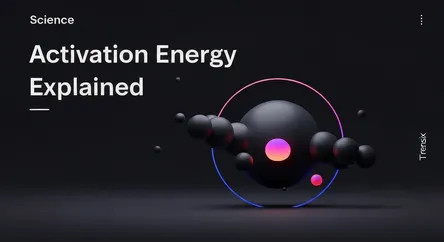Science
Activation Energy Explained

Discover activation energy, the minimum energy needed to start a chemical reaction, and how it governs the speed of reactions all around us.
What is it?
Activation energy is the minimum amount of energy required to initiate a chemical reaction. Introduced by Svante Arrhenius in 1889, it can be visualized as a barrier or hill that reactants must overcome to transform into products. For a reaction to occur, reactant molecules must collide with enough kinetic energy to break their existing chemical bonds and form new ones. This unstable, high-energy state at the peak of the barrier is called the transition state. The lower the activation energy, the faster the reaction will proceed because more molecules will have sufficient energy to overcome the barrier at any given temperature.
Why is it trending?
The concept is fundamental to chemical kinetics and has significant practical applications. In industrial chemistry, controlling reaction rates is crucial for optimizing production. Processes like the Haber-Bosch synthesis of ammonia rely on catalysts to lower the activation energy, making the reaction economically viable. In biochemistry, enzymes are biological catalysts that lower the activation energy for reactions within cells, allowing essential life processes to occur at body temperature. Understanding activation energy is also key in materials science for developing new materials and in environmental science for designing strategies to break down pollutants.
How does it affect people?
Activation energy explains many everyday phenomena. Striking a match provides the friction and heat needed to overcome the activation energy for combustion. Similarly, the heat from a stove provides the activation energy to cook food, causing the chemical reactions that change its texture and taste. Propane in a tank won't spontaneously combust because its activation energy is too high at room temperature; it requires a spark to start the reaction. In our own bodies, countless metabolic reactions would be too slow to sustain life without enzymes lowering the activation energy barriers for them.